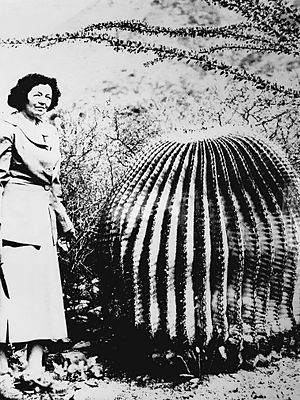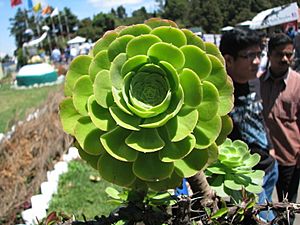Helia Bravo Hollis facts for kids
Helia Bravo Hollis (born September 30, 1901 – died September 26, 2001) was a famous Mexican botanist. She spent her life studying plants, especially cacti, and taught at the UNAM. She is remembered for her amazing work in understanding and protecting Mexico's unique plant life.
Contents
Early Life and Education
Helia Bravo Hollis grew up in Mixcoac, which is now part of Mexico City. Her love for nature began during Sunday walks with her parents. She was a very bright student from a young age. She even received special recognition from the President of Mexico for her excellent grades in primary school.
Her family faced tough times during the Mexican Revolution. Her father, who supported a leader named Francisco Madero, was killed in 1914. Even with these challenges, Helia kept studying hard. She started high school in 1919.
She attended the National Preparatory High School in Mexico City. Here, she had inspiring teachers who sparked her interest in biological sciences, which is the study of living things.
After high school, Helia first started studying medicine. Her family wanted her to become a doctor. At that time, biology was not a main subject at UNAM. But a year later, she got the chance to study biology, and she quickly switched her major.
In 1931, she earned her Master of Science degree in Biological Sciences from UNAM. Her special project was about the cacti found in Tehuacán, Puebla. Many years later, in 1985, UNAM gave her an honorary doctorate, which is a special award for her lifetime achievements.
Helia Bravo Hollis married Jose Clemente Robles, a pioneering brain surgeon in Mexico. They later divorced and did not have children. Helia retired at 90 years old because of arthritis. She passed away on September 26, 2001, just four days before her 100th birthday.
Contributions to Biology
Helia Bravo Hollis first worked in zoology, which is the study of animals. She focused on tiny living things called protozoa, some of which cause diseases. She published nine studies on them between 1921 and 1927, even while she was still a student. She also became a teaching assistant and then a professor at the National Preparatory School.
Later, she was asked to lead the biology department at UNAM. This department later became the Institute of Biology at UNAM.
In the 1950s, she returned to teaching and became a professor of botany (the study of plants) at the National School of Biological Sciences. A couple of years later, she went back to the Institute of Biology at UNAM. During this time, she helped manage the National Herbarium, which is like a library of dried plant samples.
Helia Bravo Hollis made important discoveries in the study of plants, especially in dry areas of eastern Mexico. She became an expert in the taxonomy of cactaceae, which means she was great at classifying and naming different types of cacti. She created a collection of live cacti and other succulent plants. These are plants that store water in their leaves or stems. She studied them closely to understand how they grow and what makes each type unique.
In 1951, she helped start the Mexican Cactus Society. She also helped create the Botanical Gardens at UNAM in 1959 and was its director in the 1960s. The Mexican Cactus Society published a magazine called Cactáceas y suculentas mexicanas. Helia was a leading expert on the taxonomy of cacti in Mexico. She wrote a huge book about the cacti of the Mesoamerican region. She spent a lot of time doing fieldwork, studying plants in their natural homes, and working in herbariums. She shared her findings through books, talks, and teaching.
Helia Bravo Hollis wrote more than 160 scientific papers. She described 60 new types of plants and reclassified 59 others. Her first work was published in 1921. Her most famous book, Las Cactaceas de Mexico (The Cacti of Mexico), came out in 1937. It was written in Spanish and was over 700 pages long! She later worked with another scientist to update the book. The new version, published between 1978 and 1991, grew to three volumes and over 1,800 pages. Many of her articles appeared in Cactaceas y Suculentas Mexicanas, the journal of the Mexican Cactus Society.
Honors and Recognition
Helia Bravo Hollis received many awards and honors from Mexico and around the world. In 1980, she won the Cactus d'Or Award from the International Organization for Succulent Plant Study. The Cactus and Succulent Society of America gave her a special award in 1941 for her book "Las Cactaceas de Mexico" and her other writings. Her last award was in 2000 for her work on the plants of Metztitlán, Hidalgo. This work helped create a biosphere reserve there, which is a protected area for nature.
The Helia Bravo Hollis Botanical Garden in Puebla, Mexico, is named after her. It is a special place that helps protect many endangered cactus species. UNAM also named the desert section of its own Botanical Garden after her: Jardin del Desierto Helia Bravo.
Plants Named After Her
Nine different types of plants and animals from Mexico have been named in her honor. One plant genus, Heliabravoa, was named after Helia in 1956. This shows how much her work was respected by other scientists.
Tribute
On September 30, 2018, Google celebrated Helia Bravo Hollis with a special Google Doodle on its homepage.
See also
 In Spanish: Helia Bravo Hollis para niños
In Spanish: Helia Bravo Hollis para niños



